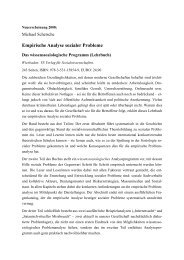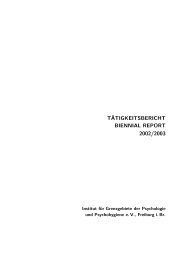Psychophysiology of False Memories in a Deese-Roediger ... - IGPP
Psychophysiology of False Memories in a Deese-Roediger ... - IGPP
Psychophysiology of False Memories in a Deese-Roediger ... - IGPP
Create successful ePaper yourself
Turn your PDF publications into a flip-book with our unique Google optimized e-Paper software.
<strong>Psychophysiology</strong> <strong>of</strong> Visual <strong>False</strong> <strong>Memories</strong><br />
To conclude, the present study can be regarded as a first step to<br />
<strong>in</strong>vestigate false memories, as provoked <strong>in</strong> a visual DRM study,<br />
with measures <strong>of</strong> peripheral psychophysiology. Differences <strong>in</strong><br />
memorability <strong>of</strong> stimulus types are an <strong>in</strong>herent problem <strong>of</strong> the<br />
classical DRM design. In the present study, this problem was<br />
brought to light and faced by the <strong>in</strong>troduction <strong>of</strong> a control group,<br />
whereas previous DRM studies did not feature control groups and<br />
could therefore not report such a memorability bias.<br />
Future DRM studies with CIT methodology might account for<br />
this problem by us<strong>in</strong>g a categorical design with a random choice <strong>of</strong><br />
the related lures. The realization <strong>of</strong> such a design seems to be<br />
challeng<strong>in</strong>g with visual scenes as study material, but it might be<br />
fruitful.<br />
The present peripheral psychophysiology study comb<strong>in</strong>es two<br />
fields <strong>of</strong> research. The phenomena <strong>of</strong> false memories and<br />
deception overlap conceptually. This is particularly important<br />
when object recognition is <strong>in</strong>vestigated psychophysiologically. The<br />
ma<strong>in</strong> difference between the two phenomena, false recognition<br />
and <strong>in</strong>formation concealment, is the level <strong>of</strong> awareness concern<strong>in</strong>g<br />
the falseness <strong>of</strong> a recognition statement. While the detection <strong>of</strong><br />
deception has been extensively studied by means <strong>of</strong> peripheral<br />
psychophysiology, this has scarcely been the case for false<br />
memories.<br />
However, the present study not only contributes to the<br />
understand<strong>in</strong>g <strong>of</strong> false memories, but from a detection-<strong>of</strong><strong>in</strong>formation<br />
perspective, the results also provide evidence for the<br />
detectability <strong>of</strong> implicit knowledge. Thus, it might also be seen as<br />
an applied <strong>in</strong>vestigation <strong>of</strong> ‘‘subception’’. Implicit knowledge might<br />
contribute greatly to the psychophysiological detectability <strong>of</strong><br />
deception; there, implicit and explicit knowledge are confounded.<br />
References<br />
1. Ben-Shakhar G, Elaad E (2003) The validity <strong>of</strong> psychophysiological detection <strong>of</strong><br />
<strong>in</strong>formation with the Guilty Knowledge Test: a meta-analytic review. Journal <strong>of</strong><br />
Applied Psychology 88(1): 131–151.<br />
2. <strong>Roediger</strong> HL, McDermott KB (1995) Creat<strong>in</strong>g false memories: Remember<strong>in</strong>g<br />
words not presented <strong>in</strong> lists. Journal <strong>of</strong> experimental psychology. Learn<strong>in</strong>g,<br />
memory, and cognition 21(4): 803–814.<br />
3. Clancy SA, McNally RJ, Schacter DL, Lenzenweger MF, Pitman RK (2002)<br />
Memory distortion <strong>in</strong> people report<strong>in</strong>g abduction by aliens. Journal <strong>of</strong> Abnormal<br />
Psychology 111(3): 455.<br />
4. Gallo DA (2010) <strong>False</strong> memories and fantastic beliefs: 15 years <strong>of</strong> the DRM<br />
illusion. Memory & Cognition 38(7): 833–848.<br />
5. Israel L, Schacter DL (1997) Pictorial encod<strong>in</strong>g reduces false recognition <strong>of</strong><br />
semantic associates. Psychonomic Bullet<strong>in</strong> and Review 4: 577–581.<br />
6. Koutstaal W, Schacter DL (1997) Gist-Based <strong>False</strong> Recognition <strong>of</strong> Pictures <strong>in</strong><br />
Older and Younger Adults. Journal <strong>of</strong> Memory and Language 37(4): 555–583.<br />
7. Koutstaal W, Schacter DL, Brenner C (2001) Dual Task Demands and Gist-<br />
Based <strong>False</strong> Recognition <strong>of</strong> Pictures <strong>in</strong> Younger and Older Adults. Journal <strong>of</strong><br />
Memory and Language 44(3): 399–426.<br />
8. Seamon JG, Luo CR, Schlegel SE, Greene SE, Goldenberg AB (2000) <strong>False</strong><br />
Memory for Categorized Pictures and Words: The Category Associates<br />
Procedure for Study<strong>in</strong>g Memory Errors <strong>in</strong> Children and Adults. Journal <strong>of</strong><br />
Memory and Language 42(1): 120–146.<br />
9. Miller MB, Gazzaniga MS (1998) Creat<strong>in</strong>g false memories for visual scenes.<br />
Neuropsychologia 36(6): 513–520.<br />
10. Jel<strong>in</strong>ek L, Hottenrott B, Randjbar S, Peters MJ, Moritz S (2009) Visual false<br />
memories <strong>in</strong> post-traumatic stress disorder (PTSD). Journal <strong>of</strong> Behavior Therapy<br />
and Experimental Psychiatry 40(2): 374–383.<br />
11. Moritz S, Woodward TS, Rodriguez-Raecke R (2006) Patients with schizophrenia<br />
do not produce more false memories than controls but are more<br />
confident <strong>in</strong> them. Psychological Medic<strong>in</strong>e 36(5): 659–667.<br />
12. Miller MB, Wolford GL (1999) Theoretical Commentary: The Role <strong>of</strong> Criterion<br />
Shift <strong>in</strong> <strong>False</strong> Memory. Psychological Review 106(2): 398–405.<br />
13. Nessler D, Friedman D, Bersick M (2004) Classic and false memory designs: An<br />
electrophysiological comparison. <strong>Psychophysiology</strong> 41(5): 679–687.<br />
14. Nessler D, Meckl<strong>in</strong>ger A, Penney TB (2001) Event related bra<strong>in</strong> potentials and<br />
illusory memories: the effects <strong>of</strong> differential encod<strong>in</strong>g. Cognitive Bra<strong>in</strong> Research<br />
10(3): 283–301.<br />
15. Allen JJB, Mertens R (2009) Limitations to the detection <strong>of</strong> deception: true and<br />
false recollections are poorly dist<strong>in</strong>guished us<strong>in</strong>g an event-related potential<br />
procedure. Social Neuroscience 4(6): 473–490.<br />
The detectability <strong>of</strong> implicit knowledge has important practical<br />
implications. The question whether a subject carries (detectable)<br />
<strong>in</strong>formation about an encounter, without hav<strong>in</strong>g conscious access<br />
to it, arises <strong>in</strong> different fields <strong>of</strong> <strong>in</strong>terest. Regard<strong>in</strong>g autobiographical<br />
memories, future applications <strong>of</strong> psychophysiological methods<br />
might help to dist<strong>in</strong>guish true from false ‘‘recovered memories’’. A<br />
future development <strong>of</strong> psychophysiological methods for the<br />
detection <strong>of</strong> implicit knowledge might also be <strong>in</strong>terest<strong>in</strong>g for<br />
medical rehabilitation, e.g. regard<strong>in</strong>g amnesia. We must however<br />
emphasize that these implications are rather speculative.<br />
To summarize, our results show that true recognition is<br />
accompanied by higher EDA responses than false recognition.<br />
Support<strong>in</strong>g Information<br />
Appendix S1 Stimulus material for the study phase<br />
(visual scenes) and extracted related lures/related<br />
controls and studied items (recognition phase).<br />
(DOC)<br />
Appendix S2 Additional stimulus material for the<br />
recognition phase (unrelated lures).<br />
(DOC)<br />
Author Contributions<br />
Conceived and designed the experiments: AB WA DV. Performed the<br />
experiments: AB WA. Analyzed the data: AB BW. Contributed reagents/<br />
materials/analysis tools: AB WA DV. Wrote the paper: AB WA.<br />
Contributed to study design and data discussion: AB WA BW DV.<br />
16. Curran T, Schacter DL, Johnson MK, Sp<strong>in</strong>ks R (2001) Bra<strong>in</strong> potentials reflect<br />
behavioral differences <strong>in</strong> true and false recognition. Journal <strong>of</strong> Cognitive<br />
Neuroscience 13(2): 201–216.<br />
17. Miller AR, Baratta C, Wynveen C, Rosenfeld JP (2001) P300 latency, but not<br />
amplitude or topography, dist<strong>in</strong>guishes between true and false recognition.<br />
Journal <strong>of</strong> experimental psychology. Learn<strong>in</strong>g, memory, and cognition 27(2):<br />
354–361.<br />
18. Abe N, Okuda J, Suzuki M, Sasaki H, Matsuda T, et al. (2008) Neural correlates<br />
<strong>of</strong> true memory, false memory, and deception. Cerebral Cortex 18(12):<br />
2811–2819.<br />
19. Cabeza R, Rao SM, Wagner AD, Mayer AR, Schacter DL (2001) Can medial<br />
temporal lobe regions dist<strong>in</strong>guish true from false? An event-related functional<br />
MRI study <strong>of</strong> veridical and illusory recognition memory. Proceed<strong>in</strong>gs <strong>of</strong> the<br />
National Academy <strong>of</strong> Sciences <strong>of</strong> the United States <strong>of</strong> America 98(8):<br />
4805–4810.<br />
20. Gonsalves B, Reber PJ, Gitelman DR, Parrish TB, Mesulam MM, et al. (2004)<br />
Neural Evidence That Vivid Imag<strong>in</strong><strong>in</strong>g Can Lead to <strong>False</strong> Remember<strong>in</strong>g.<br />
Psychological Science 15(10): 655–660.<br />
21. Kim H, Cabeza R (2007) Trust<strong>in</strong>g our memories: dissociat<strong>in</strong>g the neural<br />
correlates <strong>of</strong> confidence <strong>in</strong> veridical versus illusory memories. The Journal <strong>of</strong><br />
Neuroscience 27(45): 12190–12197.<br />
22. Schacter DL, Buckner RL, Koutstaal W, Dale AM, Rosen BR (1997) Late Onset<br />
<strong>of</strong> Anterior Prefrontal Activity dur<strong>in</strong>g True and <strong>False</strong> Recognition: An Event-<br />
Related fMRI Study. Neuroimage 6(4): 259–269.<br />
23. Slotnick SD, Schacter DL (2004) A sensory signature that dist<strong>in</strong>guishes true from<br />
false memories. Nature Neuroscience 7(6): 664–672.<br />
24. Schacter DL, Reiman E, Curran T, Yun LS, Bandy D, et al. (1996)<br />
Neuroanatomical correlates <strong>of</strong> veridical and illusory recognition memory:<br />
Evidence from positron emission tomography. Neuron 17(2): 267–274.<br />
25. Schacter DL, Slotnick SD (2004) The Cognitive Neuroscience <strong>of</strong> Memory<br />
Distortion. Neuron 44(1): 149–160.<br />
26. Ben-Shakhar G, Gati I (1987) Common and dist<strong>in</strong>ctive features <strong>of</strong> verbal and<br />
pictorial stimuli as determ<strong>in</strong>ants <strong>of</strong> psychophysiological responsivity. Journal <strong>of</strong><br />
Experimental Psychology: General 116(2): 91–105.<br />
27. Ben-Shakhar G, Frost R, Gati I, Kresh Y (1996) Is an apple a fruit? Semantic<br />
relatedness as reflected by psychophysiological responsivity. <strong>Psychophysiology</strong><br />
33(6): 671–679.<br />
28. Pavlov IP (1927) Conditioned reflexes (G V Anreptranslator). New York: Dover.<br />
29. Sokolov EN (1963) Higher Nervous Functions: The Orient<strong>in</strong>g Reflex. Annual<br />
Review <strong>of</strong> Physiology 25(1): 545–580.<br />
PLoS ONE | www.plosone.org 8 January 2012 | Volume 7 | Issue 1 | e30416


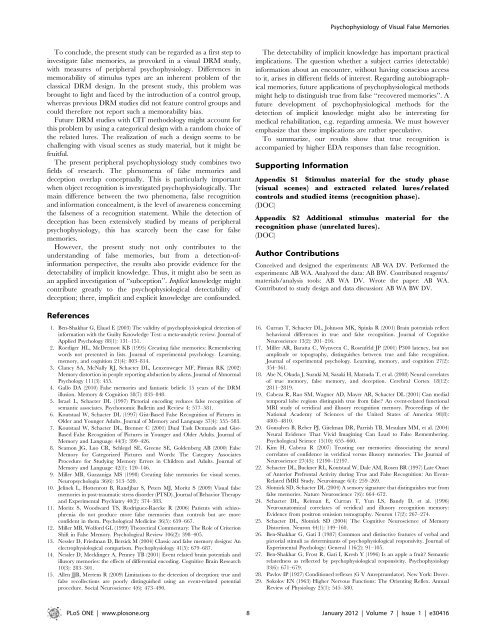
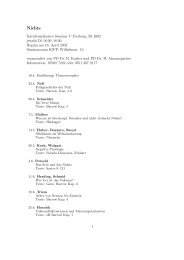
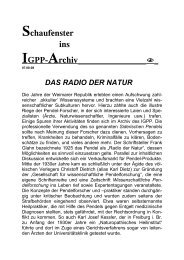
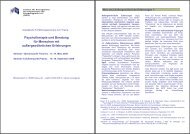
![Findliste Nachträge1 [pdf] - IGPP](https://img.yumpu.com/22552359/1/184x260/findliste-nachtrage1-pdf-igpp.jpg?quality=85)

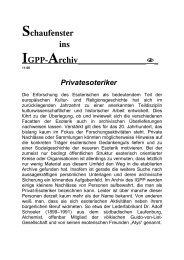
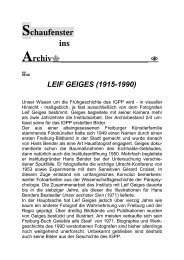
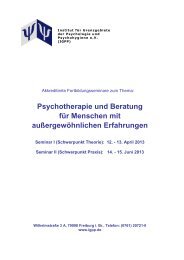
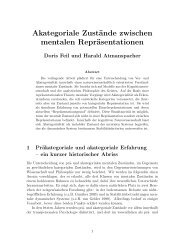
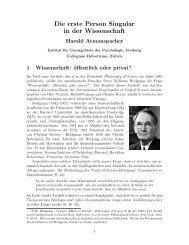
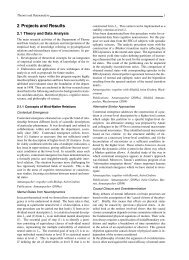
![Findliste [pdf] - IGPP](https://img.yumpu.com/22552265/1/190x245/findliste-pdf-igpp.jpg?quality=85)

